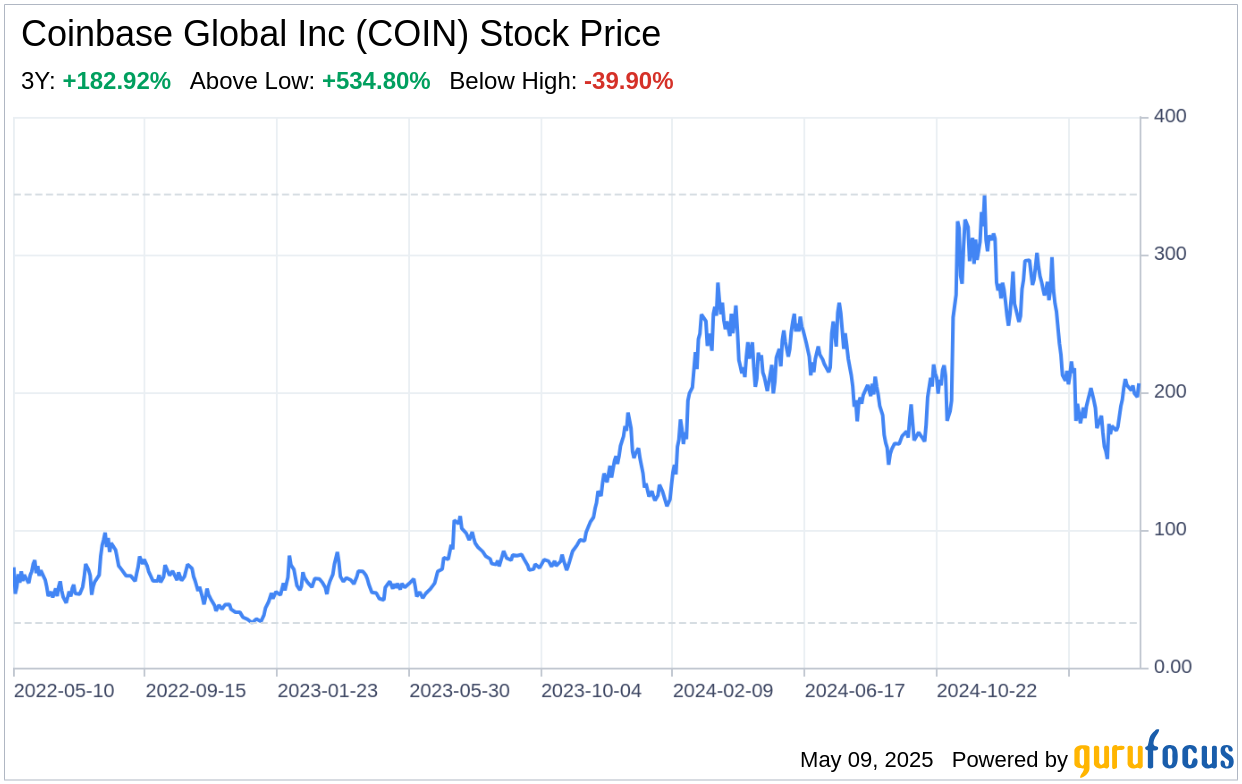On May 8, 2025, Coinbase Global Inc (COIN, Financial) filed its 10-Q with the SEC, providing a snapshot of its financial performance for the first quarter of the year. Founded in 2012, Coinbase has established itself as a leading cryptocurrency exchange platform in the United States. The company's financial tables reveal a total revenue of $2.03 million for the three months ended March 31, 2025, a notable increase from $1.64 million in the same period of the previous year. Despite this growth, net income has seen a significant decrease to $65,608 from $1.18 million, reflecting the volatile nature of the cryptocurrency market and the company's ongoing investments in technology and development. Operating expenses have also risen, particularly in sales and marketing, which jumped from $98,585 to $247,283, indicating a strategic push to expand market share and customer base. This financial overview sets the stage for a deeper SWOT analysis of Coinbase Global Inc (COIN).

Strengths
Market Leadership and Brand Recognition: Coinbase Global Inc (COIN, Financial) stands out as a market leader in the cryptocurrency exchange space, with a strong brand that resonates with both retail investors and institutions. The company's reputation for being a safe and regulation-compliant entry point into the cryptocurrency economy has been a significant draw for users. Coinbase's ability to act as a custodian for its customers' cryptocurrency assets further solidifies its position as a full-service platform, beyond the capabilities of a traditional financial exchange.
Technological Infrastructure: The company's investment in technology is evident from its operating expenses, with $355,368 dedicated to technology and development. This investment supports Coinbase's robust technological infrastructure, which is crucial for maintaining a secure and efficient trading environment. The platform's advanced trading tools and commitment to scaling derivatives globally have contributed to its growth and are likely to continue to do so in the future.
Financial Performance: Despite the volatility in net income, Coinbase's overall revenue growth is a testament to its strong financial performance. The increase in total revenue from the previous year indicates a growing user base and higher transaction volumes. This financial strength provides Coinbase with the resources to invest in new products and services, further enhancing its competitive edge.
Weaknesses
Regulatory Compliance Costs: As a company operating in a highly regulated industry, Coinbase faces significant costs associated with maintaining compliance. The evolving and uncertain regulatory landscape requires continuous investment in legal and compliance efforts, which can strain resources and impact profitability. The company's 10-Q filing acknowledges the challenges of staying compliant with laws and regulations, which could potentially limit its operational flexibility and increase operational costs.
Market Volatility Impact: The substantial decrease in net income highlights the impact of market volatility on Coinbase's financials. The company's reliance on transaction fees, which are influenced by the fluctuating prices of cryptocurrencies, introduces a level of unpredictability to its revenue streams. This weakness is exacerbated by the concentration of revenue from a limited number of areas, such as Bitcoin and Ethereum transactions, making the company vulnerable to shifts in market sentiment and price volatility.
Increased Operating Expenses: The significant increase in sales and marketing expenses reflects an aggressive strategy to capture market share. However, this also indicates a potential weakness in the company's cost structure. If the investments in marketing do not yield proportional increases in revenue, Coinbase may face challenges in managing its operating expenses and sustaining profitability.
Opportunities
International Expansion: Coinbase's strategic acquisition of Deribit, a crypto derivatives exchange, for approximately $2.9 billion, underscores its ambition to grow its global presence. This move presents an opportunity to tap into new markets and diversify revenue streams. The international expansion can also mitigate the risks associated with the concentration of revenue from specific cryptocurrencies by exposing the company to a broader range of assets and customer segments.
Product Diversification: The company's focus on developing new products and services, such as advanced trading tools and scaling derivatives, positions it well to capitalize on the evolving needs of the cryptocurrency market. By diversifying its product offerings, Coinbase can attract a wider customer base and create additional revenue sources, reducing its dependence on transaction fees alone.
Industry Growth: The cryptocurrency market is still in its nascent stages, with significant potential for growth. Coinbase's established brand and platform make it well-positioned to benefit from the increasing adoption of cryptocurrencies and the expansion of the cryptoeconomy. As more individuals and institutions seek to participate in this market, Coinbase can leverage its strengths to capture a larger share of the growing user base.
Threats
Competitive Landscape: The cryptocurrency exchange market is becoming increasingly crowded, with new entrants and existing players vying for market share. Coinbase faces competition from both regulated and less regulated companies, some of which may have greater financial and other resources. The rise of decentralized and noncustodial platforms also poses a threat, as they offer alternatives to traditional exchange models and could potentially draw away users seeking different trading experiences.
Regulatory Uncertainty: The regulatory environment for cryptocurrencies remains highly uncertain and subject to change. Adverse regulatory developments or failure to comply with existing or new regulations could significantly impact Coinbase's operations and financial condition. The company's 10-Q filing acknowledges the risk of increased scrutiny and the potential for regulatory actions that could harm its business and reputation.
Economic and Market Conditions: The performance of the cryptocurrency market is influenced by a range of macroeconomic factors, including interest rates, inflation, and global events. Economic downturns or
This article, generated by GuruFocus, is designed to provide general insights and is not tailored financial advice. Our commentary is rooted in historical data and analyst projections, utilizing an impartial methodology, and is not intended to serve as specific investment guidance. It does not formulate a recommendation to purchase or divest any stock and does not consider individual investment objectives or financial circumstances. Our objective is to deliver long-term, fundamental data-driven analysis. Be aware that our analysis might not incorporate the most recent, price-sensitive company announcements or qualitative information. GuruFocus holds no position in the stocks mentioned herein.
